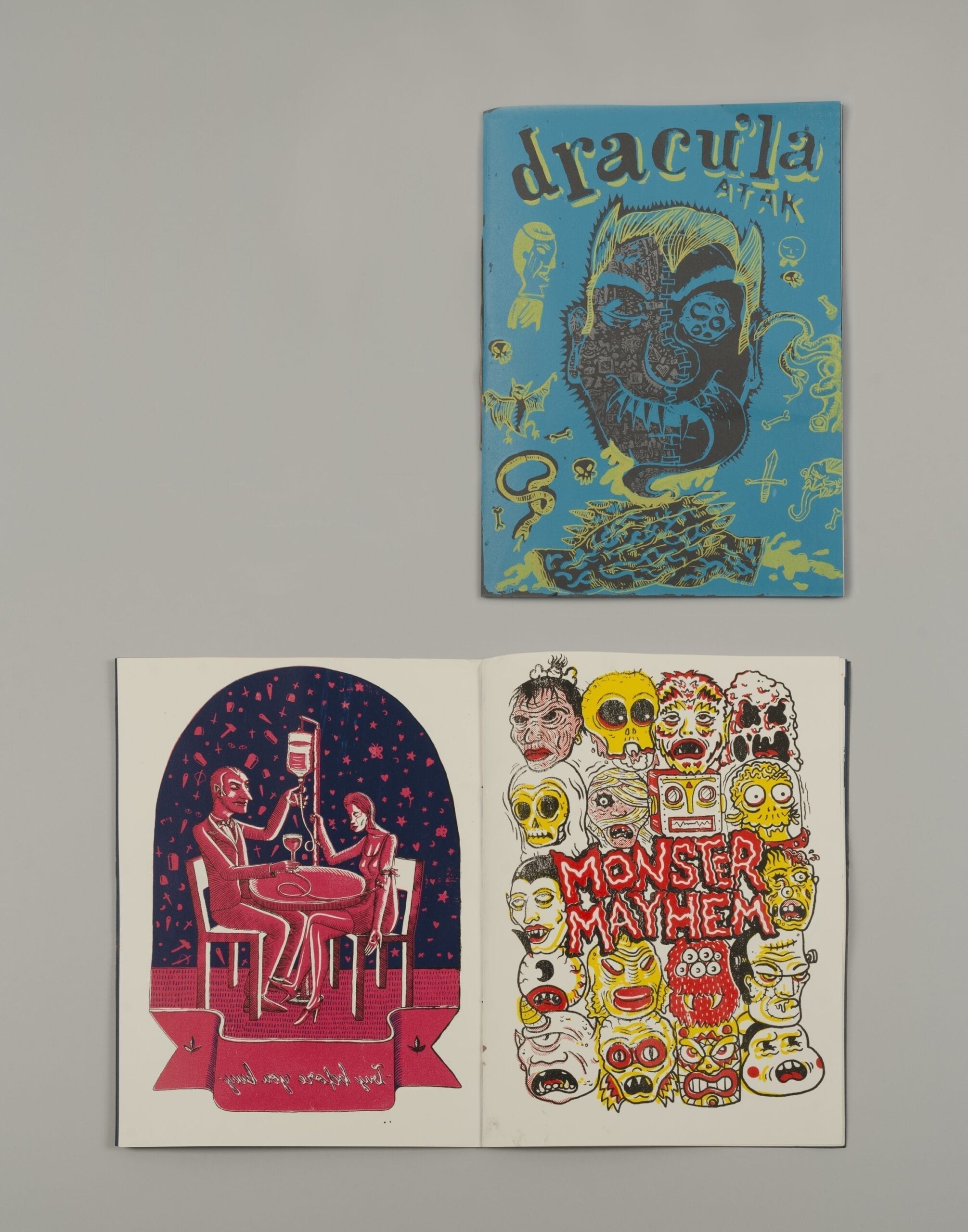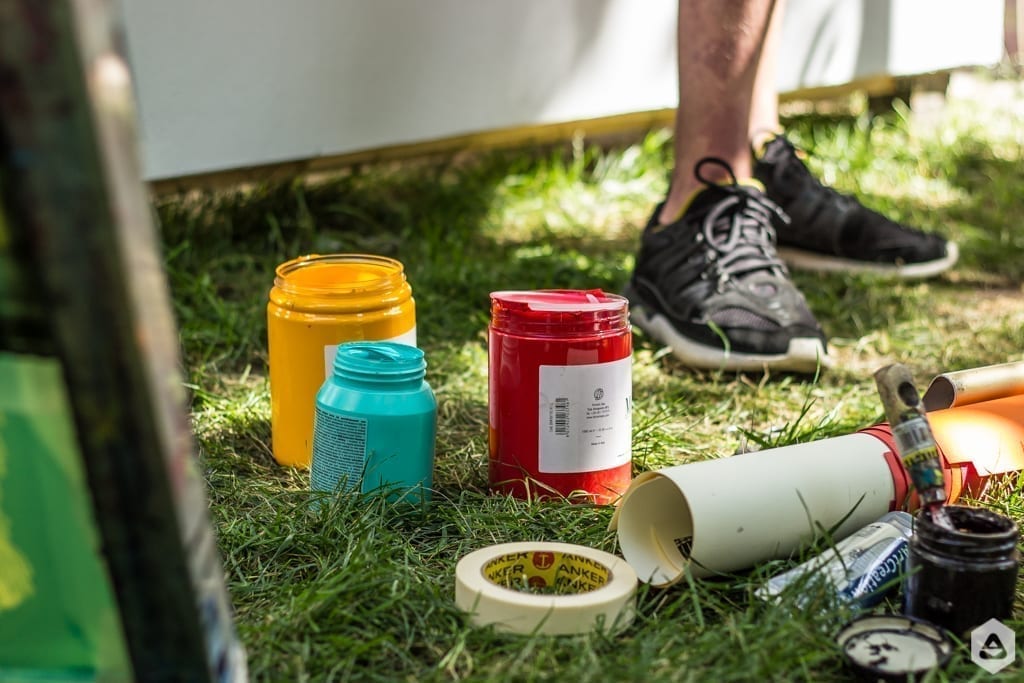We’ve entered, thanks to Primitiv Print, in the backstage of a creative niche field in our country – screen printing. What makes this technique unique and what is different compared to the digital print, what organising a screen printing workshop involves, the must-read books and zines, as well as the city as a source of inspiration for unexplored artistic universes, are just some of the topics we focus on in our latest Un-hidden Bucharest interview.
f: We’ll start with curiosity. Why Primitiv Print [Primitive Print]? Is printing losing ground in front of technology or are we returning to the origins to rediscover its beauty?
Primitiv Print: When I started all was more primitive, I improvised tools, methods, pigments and media. There are probably a few people among us who still know how to make linoprints, yet the future is moving towards automation. Many people confuse the software and the set of skills accumulated with creating a poster.
Doing a job manually you give it more attention. It’s the type of paper, the ink, the sieve, the mood you have when you print. Screen printing covers a wide range of hard surfaces, inaccessible to the digital print. It infiltrates into the environment of everyday life without noticing it. From stickers to t-shirts to computer keys (printed through a method similar to screen printing), the car board or street signs (many of which were originally silk-screened). Compared to the digital print, screen printing may seem more rudimentary. However, before the internet, it was one of the few underground methods of multiplication of revolutionary messages, zines, subversive messages…
f: Just a few months ago, Steven Heller recommended your collection Burnt a.k.a. Gotta catch ’em all in Print Magazine. Tell us about the project, who contributed to the concept, the reactions so far and if you plan to expand it in the following period.
Primitiv Print: The idea started from the mountains of everyday frustration, accumulated amid local and global political instability. Everyone who interacted with the matches was glad they could burn out a few troubles and worries. The plans for extending the project have not yet been finalised, but we’re thinking of creating a division in Singapore.

f: You were among the participants at events such as the Hot Lagoon Fair series – recently hosted by MNAC – and BAZAR Timișoara, you had your work showcased at RDW 2018. How does the public’s perception of materials created through screen printing – books, posters, textiles, etc. evolve? Does it remain a niche field loved by the connoisseurs or do you feel that there is an increase in the interest in this technique and its products?
Primitiv Print: Many people are enthusiastic and want to work with screen printing. However, the stages of working in the studio make them lose their interest gradually. There’s a constant interest in alternative printing methods, experimental forms of engraving the medium. Screen printing will continue to be used, it depends on the curiosity of the public if interest increases in Romania.
f: You also organise a lot of workshops, the most recent being CMFC. What’s the vibe at these meetings? How do you interact with the new generations eager to learn screen printing?
Primitiv Print: The participants at workshops are either curious or people who study/work in related fields (design, textiles, photography). It’s difficult to outline a general atmosphere, the children are more uninhibited, adolescents have a lower attention span sometimes, students are either greatly involved, or bored.
The interaction starts with a few exercises and continues with browsing through the books brought at the workshop (some are about screen printing), we look at posters and other screen printed materials (some from comics fairs). Depending on the hours or days we have available, the results can consist of t-shirts, bags and handkerchiefs, posters, magazines or bachelor’s/master’s degree projects.

f: What do you like about screen printing and what determined you to launch your studio and share its secrets with others?
Primitiv Print:
You become addicted, you start printing on anything, on walls, on t-shirts, you begin organising workshops, contaminating other innocent young people with alternative printing methods. Gradually, you build a mini-empire of screen printing, like Le Dernier Cri, and you dream that someday things will work out for themselves.
f: What are the top 3 books or zines created through screen printing and signed by Romanian and/or international artists that you’d like to recommend to feeder.ro readers?
Primitiv Print: The books of Blexbolex, who worked for years screen printing, the zine resulted from the workshop organised by Jumătatea Plină with the Berlin artist Atak and Liberté à quatre sous, by Atak. It’s completely screen-printed, there seem to be 14 colours, but surely there are more, there are 300 copies, and it was printed by Pipifax, Siebdruck Alligator, Lenzburg Zürich.

f: What haven’t you tried yet in the creative-artistic field and would like to experience at the first opportunity?
Primitiv Print: Decor and scenography for a musical.

f: Whether we’re talking about t-shirts or posters, over time, in your collection you had several executions with and about Bucharest. How do you think the capital has inspired the artists you worked with?
Primitiv Print:
Some are trying to improve a certain thing around them, others are in search of collaborations, graffiti artists such as ERPS remain imprinted in the memory of the walls, there are people who just want to make a small gift, a cover, a flag, each of the people I worked with has let himself/herself inspired by Bucharest, beyond all flaws.
f: At the first edition of Un-hidden Bucharest, you collaborated with Sorina Vazelina for an installation at Lente. The theme of your intervention was focused on the different masks we carry as time passes. Share with us a few impressions about the event – why you chose this particular theme, how was the working process and taking screen printing outdoors.
Primitiv Print: Screen printing outdoors is ok. You get the courage to try all sorts of things. We adapted to the environment, improvised a printing table on the stairs of Lente, for the small zine containing a comics about the passage of time.
Sorina had already drawn a series of old people and, besides, we printed some masks (like those that inspired Marcel Janco at some point) that we were going to give to the visitors. It was harder to share the work on the wall with that on paper, it rained a couple of times while we were drying the masks and the screen printed wall with the foehn. After all, you have to adapt, and screen printing allows you to do this, although you need much equipment.
f: In your old portfolio we also found several designs of business cards. If Bucharest had a business card, what would you write on it?
Primitiv Print: primitive
You can follow Primitiv Print on his website, on Facebook and Instagram.
View his intervention for Un-hidden Bucharest in collaboration with Sorina Vazelina on the project’s map.
This article is part of the Un-hidden Bucharest series of interviews with street art and graffiti artists, published weekly on feeder.ro. Together we will enter their artistic universe and learn how the city can be regenerated through artistic interventions in the public space.
Keep your eyes on feeder.ro, we’ll publish new interviews soon with iZZY iZVNE, Maria Bălan, John Dot S, Livi Po, J.Ace, Robert Obert, KSELEQOQYNQYSHY, Pisica Pătrată, Skinny Bunny, Alexander Blot, Irina Marinescu, Kero, Lost.Optics, Obie Platon, Serebe, Alina Marinescu, Cage, Livia Fălcaru and more.
Interview by Emilia Cazan
Images © Primitiv Print, feeder.ro (Alex Iacob), Sebi Hogea, @gabrielacozma, printmag.com, celemaifrumoasecarti.ro, blog.picturebookmakers.com.
The Un-hidden Bucharest street art project is organized by Save or Cancel, through feeder.ro and is co-funded by AFCN. The program does not necessarily represent the position of the National Cultural Fund Administration. AFCN is not responsible for the content of the program or the way the program results can be used. These are entirely the responsibility of the beneficiary of the funding.
Organizer: The Save or Cancel team, composed of Cristina Popa (random) – social designer, editor, and cultural manager, and Andrei Racovițan (ubic) – architect, editor, and artistic manager, together with the audience, artists, collaborators și partners.
Project partners: CNDB, Faculty of Sociology and Social Work, Zeppelin, IQads, Urban Collectors, Igloo, Urban things, România Pozitivă, IQool
About Save or Cancel
Since 2008, Save or Cancel is a medium of communication and propagation of the arts and culture, promoting and facilitating their role in contemporary society.
The self-initiated multidisciplinary programs of Save or Cancel aim to identify sustainable and adaptable opportunities for (re) valorization of the existence through architectural, cultural and editorial projects.
Visit the project’s page to find out more about past, current and future activities: https://feeder.ro/un-hidden





































Pingback: Buy the Un-hidden Street Art in Romania BOOK with a 20% discount • feeder.ro
Pingback: The Un-hidden Street Art in Romania Book is now available in the feeder.ro/shop - Save or Cancel
Pingback: Un-hidden street art in Romania BOOK (preview)
Pingback: Interview with Tobias Barenthin Lindblad (SE) – Un-hidden Bucharest [en]
Pingback: Discover a new Un-hidden Romania 🇷🇴 interview with Japanese 🇯🇵 artist Aito Kitazaki [video] • Feeder.ro